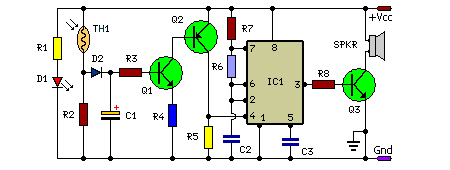Home » Circuits
Fire Alarm Using Thermistor
Small and simple unit, Can be used for Home-Security purposeIn this fire alarm circuit, a Thermistor works as the heat sensor. When temperature increases, its resistance decreases, and vice versa. At normal temperature, the resistance of the Thermistor (TH1) is approximately 10 kilo-ohms, which reduces to a few ohms as the temperature increases beyond 100 C. The circuit uses readily available components and can be easily constructed on any general-purpose PCB.
Circuit Diagram:
Parts:
R1 = 470R
R2 = 470R
R3 = 33K
R5 = 560R
R4 = 470R
R6 = 47K
R7 = 2.2K
R8 = 470R
C1 = 10uF-16V
C2 = 0.04uF-63V
C3 = 0.01uF-63V
Q1 = BC548
Q2 = BC558
Q3 = SL100B
D1 = Red Led
D2 = 1N4001
IC1 = NE555
SPKR = 1W-8R
TH1 = Thermistor-10K
Circuit Operation:
Timer IC NE555 (IC1) is wired as an astable multivibrator oscillating in audio frequency band. Switching transistors Q1 and Q2 drive multivibrator IC1. The output of IC1 is connected to NPN transistor Q3, which drives the loudspeaker (SPKR) to generate sound. The frequency of IC1 depends on the values of resistors R6, R7 and capacitor C2. When Thermistor TH1 becomes hot, it provides a low-resistance path to extend positive voltage to the base of transistor Q1 via diode D2 and resistor R3. Capacitor C1 charges up to the positive voltage and increases the ‘on’ time of alarm. The higher the value of capacitor C1, the higher the forward voltage applied to the base of transistor Q1. Since the collector of transistor Q1 is connected to the base of transistor Q2, transistor Q2 provides positive voltage to reset pin 4 of IC1. R5 is used such that IC1 remains inactive in the absence of positive voltage. D2 stops discharging of capacitor C1 when the Thermistor connected to the positive supply cools down and provides a high-resistance (10k) path. It also stops the conduction of Q1. To prevent the Thermistor from melting, wrap it up in mica tape. The circuit works off a 6V-12V regulated power supply. D1 is used to indicate that power to the circuit is switched on.

